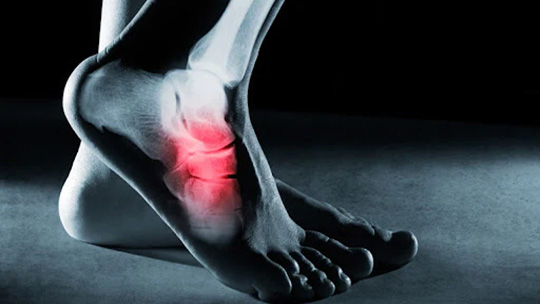Accessory Navicular Syndrome
The Accessory Navicular is an extra bone or piece of cartilage located on the inner side of the foot just above the arch. People who have accessory naviculars are often unaware of it, if it does not cause any complications. However, it can develop into a painful condition referred to as Accessory Navicular Syndrome.
WHAT CAUSES ACCESSORY NAVICULAR SYNDROME?
The Accessory Navicular is mainly congenital (it is present at birth).
HOW DO I KNOW IF I HAVE ACCESSORY NAVICULAR SYNDROME?
WHAT ARE THE SIGNS/SYMPTOMS OF ACCESSORY NAVICULAR SYNDROME?
- Pain in the foot following trauma (such as after an ankle sprain)
- Chronic irritation from shoes or other footwear rubbing against the bone
- A visible bony prominence on the inner side of the foot just above the arch
- Redness and swelling of that area
- Vague pain or throbbing in the arch mostly occurring during or after periods of physical activity
Symptoms appear most often during adolescence, but some may not occur until adulthood.
HOW IS ACCESSORY NAVICULAR SYNDROME DIAGNOSED?
To diagnose accessory navicular syndrome, the foot and ankle surgeon will ask about symptoms and examine the foot, looking for skin irritation or s welling. The doctor may press on the bony prominence to assess the area for discomfort. Foot structure, muscle strength, joint motion, and the way the patient walks may also be evaluated.
X-rays are usually ordered to confirm the diagnosis. If there is ongoing pain or inflammation, an MRI or other advanced imaging tests may be used to further evaluate the condition.
WHAT CAN I DO FROM HOME FOR ACCESSORY NAVICULAR SYNDROME?
WHAT CAN I DO TO PREVENT ACCESSORY NAVICULAR SYNDROME?
Since the formation of an Accessory Navicular is during birth, there is little opportunity to prevent Accessory Navicular Syndrome.
WHAT TREATMENTS CAN I DO FROM HOME FOR ACCESSORY NAVICULAR SYNDROME?
To reduce swelling a bag of ice covered in a thin towel can be applied to the affected area. Oral nonsteroidal anti-inflammatory drugs (NSAIDs), such as ibuprofen, can assist in the reduction of inflammation. Reducing painful activities and resting the foot can also help reduce inflammation.
WHEN SHOULD I SEE A DOCTOR FOR ACCESSORY NAVICULAR SYNDROME?
If you have persisting pain and inflammation in the arch of the foot, a medical diagnosis may be needed.
TREATMENTS YOUR DOCTOR MAY RECOMMEND FOR ACCESSORY NAVICULAR SYNDROME
Non-Surgical
The foot may be placed in a cast or removable walking boot to allow the affected area to rest and decrease the inflammation. Physical therapy including exercises and treatments to strengthen the muscles, decrease inflammation, and prevent recurrence of the symptoms. Custom orthopedic devices that fit into the shoe providing arch support. Even after successful treatment, symptoms may reappear.
Surgical
Surgery may involve removing the accessory bone, reshaping the area, and repairing the posterior tibial tendon to improve its function. This bone is not needed for normal foot function.

